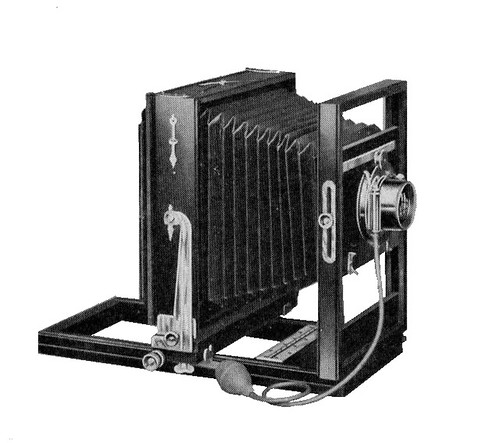Difference between revisions of "Competitor View"
(Rewrote some of the text. Gone with cherry wood, as McKeown says; no ref for mahogany, which the article said. +date, +cats, and corrected image rights.) |
(More text, three refs.) |
||
| Line 10: | Line 10: | ||
}} | }} | ||
</div> | </div> | ||
| − | The '''Competitor''' is a | + | The '''Competitor View''' is a view camera made by [[Seneca]] from about 1907-25,<ref name=McK>{{McKeown12}} p886.</ref> It was made in three sizes, for 5x7, 6½x8½ and 8x10 inch. It is wooden bodied (McKeown states that it was available in cherry or another pale wood;<ref name=McK/> Karen Nakamura at ''Photoethnography'' states that her example is in a light-coloured mahogany wood.<ref name=PE>[http://photoethnography.com/ClassicCameras/SenecaCompetitorView.html 5x7-inch Competitor View] at Karen Nakamura's [http://photoethnography.com/ClassicCameras/ Photoethnography].</ref>). ''Photoethnography'' also states that the camera was first made with brass fittings, and only rise (i.e. no sideways shift) on the front standard. Later cameras have nickel-plated brass fittings, as well as shift. All the cameras have tilt and swing at the rear. The camera has rack-and-pinion focusing (moving the rear standard). It has a reversing back. |
| + | |||
| + | |||
| + | It may be seen with a [[Rapid Rectilinear]] lens or triple [[convertible lens]], and Seneca's own Uno, Duo or Autic shutter. Both the example at ''Photoethnography'' and that at ''David Photography''<ref>[http://www.clickondavid.com/index-67.html 5x7-inch Competitor View] at David K Hoyt's [http://www.clickondavid.com/index-3.html David Photographic].</ref> have a Wollensak Gammax No. 2, though it is not certain this is the original lens these cameras were sold with. | ||
==Notes== | ==Notes== | ||
<references/> | <references/> | ||
| + | |||
| + | |||
| + | ==Links== | ||
| + | * [http://www.piercevaubel.com/cam/seneca/sencomp1.htm Half-plate Competitor View] at Mathew Brady's [http://www.piercevaubel.com/cam/index.htm Wooden Field Cameras of the United States: 1870's-1930s]. | ||
Revision as of 18:47, 19 June 2012

|
| Scan by Uwe Kulick (Image rights) |
The Competitor View is a view camera made by Seneca from about 1907-25,[1] It was made in three sizes, for 5x7, 6½x8½ and 8x10 inch. It is wooden bodied (McKeown states that it was available in cherry or another pale wood;[1] Karen Nakamura at Photoethnography states that her example is in a light-coloured mahogany wood.[2]). Photoethnography also states that the camera was first made with brass fittings, and only rise (i.e. no sideways shift) on the front standard. Later cameras have nickel-plated brass fittings, as well as shift. All the cameras have tilt and swing at the rear. The camera has rack-and-pinion focusing (moving the rear standard). It has a reversing back.
It may be seen with a Rapid Rectilinear lens or triple convertible lens, and Seneca's own Uno, Duo or Autic shutter. Both the example at Photoethnography and that at David Photography[3] have a Wollensak Gammax No. 2, though it is not certain this is the original lens these cameras were sold with.
Notes
- ↑ 1.0 1.1 McKeown, James M. and Joan C. McKeown's Price Guide to Antique and Classic Cameras, 12th Edition, 2005-2006. USA, Centennial Photo Service, 2004. ISBN 0-931838-40-1 (hardcover). ISBN 0-931838-41-X (softcover). p886.
- ↑ 5x7-inch Competitor View at Karen Nakamura's Photoethnography.
- ↑ 5x7-inch Competitor View at David K Hoyt's David Photographic.